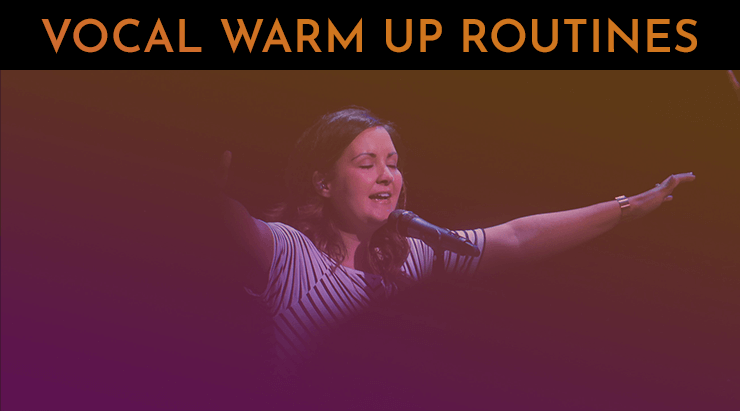Vocal Warm Ups - Building a Routine
October 9, 2019
By Camille van Niekerk
Vocal warm ups. How should you warm up? Which warm-ups should you use? Why do you need warm-ups in the first place?
You’re committed to improving your singing voice, and you’ve been told that you should warm up your voice before singing.
Read on to get these questions answered and learn the steps to a thorough warm-up routine!
First, why do I need to warm up?
Similar to a physical warm-up before lifting weights or deep stretching, we warm up to prepare for singing and prevent injury.
A good warm up will do that by:
1. Establishing good posture and breath support
2. Getting blood flow to the vocal folds
3. Gradually stretching the vocal folds
4. “Placing” the voice (using your resonant space for beautiful tone and volume, rather than pushing)
Secondly, we warm up to improve our vocal technique! Vocal exercises use a variety of vowel sounds and melodic patterns, so you develop stability and consistency throughout your range. Because you’re gradually moving up and down in pitch, warm-ups will quickly expose weak spots in a way that songs can sometimes hide. Depending on your song choice, your warm-up might be the most challenging part of your practice!
There are a number of great warm up and vocal health tutorials you can find here. And if you want a tutorial to learn all about daily warm ups, check out the lesson below.
What’s the difference between a warm-up and a vocal exercise?
Those terms are used interchangeably! The only real difference would be in their function: if it’s an exercise used to “wake up” and get your voice moving, we’d call it a warm-up. More challenging patterns that work on belting, large leaps, or fast passages, we’d call vocal exercises.
What’s the BEST warm-up?
Each singer and voice teacher probably have a different favorite. My personal all-around favorite is the lip trill (lip roll/lip bubble) because it’s great for activating the correct muscles for breath support, relaxing the face, finding balanced resonance, navigating over vocal breaks, and helping the vocal folds keep vibrating together as they stretch.
That said, I’m also a big fan of the NG for exploring high head voice, the dopey MUM for stabilizing the larynx and opening the throat, and exercises beginning with a G or B to train cord compression.
Each exercise has a different function; it’s important to know what that function is so that if a specific syllable or pattern isn’t helping you achieve that goal, you’ll find one that does! For example, if the goal is maintaining a lifted soft palate and an exercise uses the UH vowel, but it’s easier for you to keep your palate lifted with an AH vowel, you can modify!
When it comes to warm-ups, they’re just syllables and melodic patterns in different combinations. There’s no magic combo; but you’ll probably find some favorites!
Alright, I’m convinced. How should I get started?
Here are a few tips BEFORE you start singing!
1. Find a space to practice that gives you some privacy, room to move around, and (ideally) a little reverb/echo.
2. Build the habit of practicing in a standing position.
3. Commit to a little bit each day (5-10 minutes) and keep going for a longer session if you’re feeling good!
Does it matter which order I go in?
Yes! Always start with something gentle to stretch out the cords and get your voice moving. Save more challenging exercises (ie: belting) for later in your warm-up!
What should I be focused on, and how do I know if I’m doing it right?
For each and every exercise in your warm-up, always prioritize good posture, low relaxed breathing, and freedom (feeling good while you sing). If that’s happening, you’re on the right track! But if you come out of alignment, forget to breathe well, or start to feel pain and strain, stop! Then see if you can reset, modify the warm-up, or try again later. If it’s a range issue (as in, the note is way too high or too low for you to sing), you can always drop out and rejoin when you’re able!
Give me my warm-up routine, please!
This is a sample routine you can modify, depending on your goals and timeframe on any given day!
1. Breathe deeply, relaxing your belly so the belly, ribs, and back expand with your breath.
2. Stretch out your neck, jaw, face, sides, etc.
3. Activate your breath support muscles with a hiss exercise.
4. Begin vocalizing on something easy to start stretching out the cords: lip roll, HM (hum), or NN.
5. Sing on an easy, relaxed OO vowel to work on good, consistent resonance throughout your range.
6. Open up to an AH, YAH, UH, or YUH to relax the jaw down and lift the soft palate up.
7. Train healthy cord compression: use syllables that begin with a G or B and/or work on achieving a balanced onset (starting the sound with a vowel, careful to not begin with excess air or a glottal attack).
8. Get into mix voice with an NG, NYAH, NAY, MUM, or BUH.
9. Work on agility with exercises that cover a wide range, focusing on pitch accuracy and vowel modification (as needed).
10. Exercise your belt/high chest voice with a NO or HEY exercise, being sure to keep the throat and face relaxed, supporting with the low body.
11. Warm down: If you spent quite a bit of time working out, warm down with a gentle hum or lip trill.
Last thought!
If you have very limited time, just visit the basics: stretch and breathe, warm up on a lip trill or easy syllable, and sing something that makes you happy!



